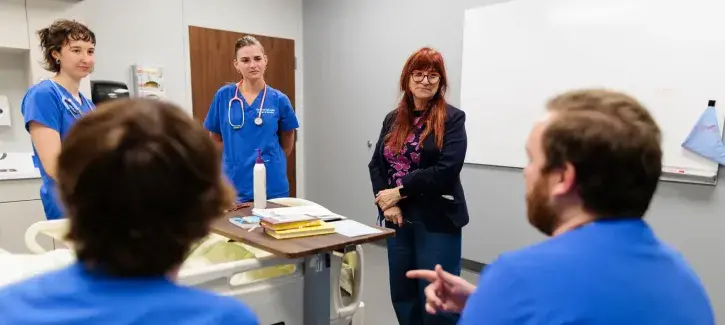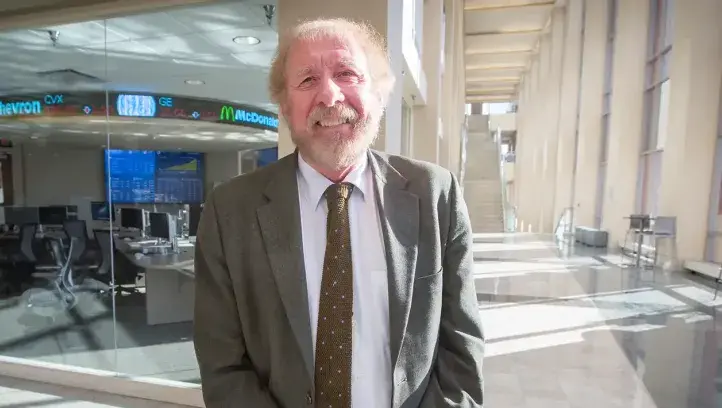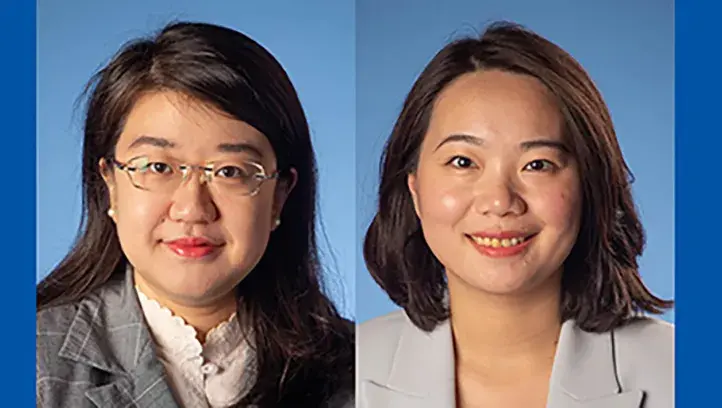
Creighton’s CCEI 2.0 goes global with Laerdal partnership

True innovators often don’t realize they’re making an impact—because for them, innovation is second nature. When Martha Todd, PhD, MS’07, APRN-NP, and Julie Manz, PhD, BSN’98, MS’05, RN, CNE, and their team created the original Creighton Simulation Evaluation instrument© (CSEI), they were working decades ahead of their time, unaware that their groundbreaking tool would one day be adopted on an international scale through a partnership with Laerdal Medical.
In the early 2000s, Todd recognized a critical gap in nursing education: while high-fidelity simulation was gaining momentum, there was no reliable way to assess nursing students’ clinical competence in these settings. For her thesis, she aligned simulation experiences with the American Association of Colleges of Nursing (AACN) core competencies—but felt the work was incomplete.
“If we really made simulations geared toward nursing, there would still be no way to assess core competencies,” Todd recalls. “That’s when I spoke with Julie about simulation assessments.”
Together with Kim Hawkins, PhD, MS’07, APRN, Mary Tracy, PhD, BSN’76, RN, and Maribeth Hercinger, PhD, BSN’76, RN, Todd and Manz co-developed the Creighton Simulation Evaluation Instrument (CSEI) in 2008—an objective tool that measured broad competencies like critical thinking, communication, assessment and technical skills.
“We flipped the AACN core competencies and worked backward,” says Todd.
What started as a scholarly article quickly gained traction. Educators across the country began reaching out, assuring the team that this tool was meeting an urgent and unaddressed need. “That was the moment where we all looked at each other and went ‘oh wow, we have something here,’” says Manz.
What followed was a period of refinement, conducting further studies and developing training to ensure the tool could be used reliably across programs. “We had to be smart about training people so they understood how to use it because it was very novel,” says Todd. “It’s very different than other instruments out there,” noting that it can be leveled across different learners, adapted to various care settings and used with different patient acuities.
In 2012, the National Council of State Boards of Nursing selected the CSEI for a landmark national study on simulation, further validating the tool’s effectiveness. That collaboration laid the groundwork for the tool’s next evolution: the Creighton Competency Evaluation Instrument© (CCEI).
By 2019, nursing education was undergoing a major shift toward competency-based learning, driven by concerns that new graduates were not practice-ready. “There was an academic-practice gap,” Manz explains. While schools were meeting academic outcomes, clinical partners said students still lacked essential real-world skills.
“The AACN and the National League for Nursing (NLN) formed huge think tanks and came up with 220 competency statements for entry-level nurses that are agreed upon between practice and academia,” says Manz. “These are the 220 essential behaviors that nurses who graduate need to be competent in.”
Meanwhile, Todd and Manz had already spent more than a decade assessing competencies. “Because of these new essentials and this big paradigm shift to competency-based education assessment, schools are struggling to find ways to assess their students, so that’s why we’re key right now,” says Todd. The research team, with new members Lindsay Iverson, BSN’05, MSN’09, DNP’11, APRN, ACNP; Sarah Ball, PhD, RNC-OB, C-EFM, CHSE; and Lucas Manning, DNP, RN, CHSE, developed the CCEI 2.0, updating the language to reflect the current trends in nursing education and to expand its use to advanced practice nurses. “We have a tool that allows them to do that—and it’s already known,” Manz adds.
Today, the CCEI is used in all 50 states, in over 30 countries and is translated into nine languages.
New partners: Creighton and Laerdal Medical
The partnership between Creighton College of Nursing and Laerdal Medical is a pivotal moment in the journey of the CCEI. After years of research, validation and widespread adoption, the tool’s reach will further expand through collaboration with one of the most recognized names in simulation technology.
"At Laerdal, we believe that empowering nursing educators with valid and reliable assessment tools is vital for developing competent healthcare professionals,” says Laerdal Medical Chief Learning Officer Michael Sautter. “Our collaboration with Creighton University allows us to expand the reach of the Creighton Competency Evaluation Instrument©, ensuring that faculty worldwide have access to the necessary training and resources to implement it effectively."
“They saw the value of a tool that was already evidence-based, already validated and already used nationally,” says Manz. “It aligned with their own mission of helping save lives through quality education. I think it’s going to be extraordinary for Creighton.”
The research team—including Tracy, Hawkins and Hercinger (mentioned above), Lindsay Iverson, BSN’05, MSN’09, DNP’11, APRN, ACNP; Sarah Ball, PhD, RNC-OB, C-EFM, CHSE; and Lucas Manning, DNP, RN, CHSE—is contracted with Laerdal to disseminate the CCEI 2.0 to a global audience.
The 2.0 version places a higher emphasis on clinical judgement, is applicable in acute care and public health and can also be used in graduate nursing education. The team has published on the conceptual framework and initial validity testing of the tool. Additional validity and reliability testing of the tool with prelicensure nursing students in simulation has been completed. Current research is underway to test the tool with advanced practice nursing students in high-fidelity simulation and with standardized patients.
Future work will be focused on further refinement and testing of the tool in additional populations and contexts.
"This collaboration represents a significant step forward in nursing education,” says Sautter. “By combining Laerdal's expertise in simulation with Creighton's valid and reliable tool, we are dedicated to equipping educators with the evidence-based resources and tools they need to cultivate the next generation of competent healthcare providers."
Manz dives into specifics, explaining that “faculty can collect and track data over time on student performance in their simulations that will be categorized according to our instrument.” She adds that this tool will allow for instantaneous feedback on skills like clinical judgement behaviors—recognizing and analyzing cues, generating solutions and more.
Beyond helping individual students, faculty can also identify gaps in curriculum through aggregating the data for cohorts, seeing where the whole is performing in areas of clinical judgement, communication, safety and more.
“This is what the AACN is calling for—the ability to track people in specific instances and for points of remediation,” says Todd. “In our partnership with Laerdal, this is what we will be able to supply to schools.”
A Shared Vision for the Future of Nursing
What began as a small project is now a vital tool used across continents, languages and levels of care. And yet, for Martha Todd and Julie Manz, the mission hasn’t changed.
“Our goal at the very beginning of this was to make an instrument to allow us to objectively assess students in simulation so that they’d be better practitioners for our world,” says Manz. “And now with Laerdal, the potential of this instrument is so exciting. That mission is still the same.”
Together with Laerdal Medical, Creighton’s nurse educators are not only expanding the tool’s capabilities—they’re reinforcing a shared commitment to prepare confident, capable and safe practitioners. “It’s about ensuring that the student walking into a patient’s room for the first time is ready,” says Todd. “With Laerdal, we’re scaling that mission.”
And in doing so, they’re not just improving nursing education—they’re improving patient care everywhere.




